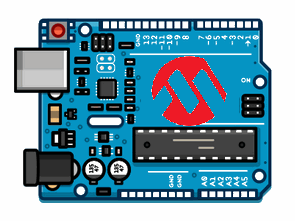
Some projects with PIC Microcontrollers have been implemented with Arduino modules. Converting Arduino software for PIC or vice versa, though not very interesting. There are Arduino and PIC source codes.
Arduino Talking Clock
The watch tells the time by playing tracks from the SD card. SD is FAT32 format. Tracks are 22,050 KHz, 8 bit, mono wave .wav files. SD card interface is in PI SPI mode. The LCD module is 2 lines 16 characters. ATMEGA328P produces sound using PWM. Talking_clock_hourly software is an hourly announcement. Disables hourly announcement when NIGHT SWITCH is off.
The audio tracks can be any sound. The code does not read the file name, it goes to the file number in the 27 file list. Code plays the tracks in the following order. The SD card should be prepared as follows: Files should be 22,050 KHz, 8 bit, mono. With short names (up to 8 characters). Format the card with FAT32. There should be no folder or subfolder.
Copy the files to the root folder in order; 0 to 19 (20 files), 20,30,40,50, “hours”, “minutes”, “good day” or other messages. 27 files in total. If you make a mistake while copying the files to SD, it is not enough to delete a file, you have to format the SD and start again.
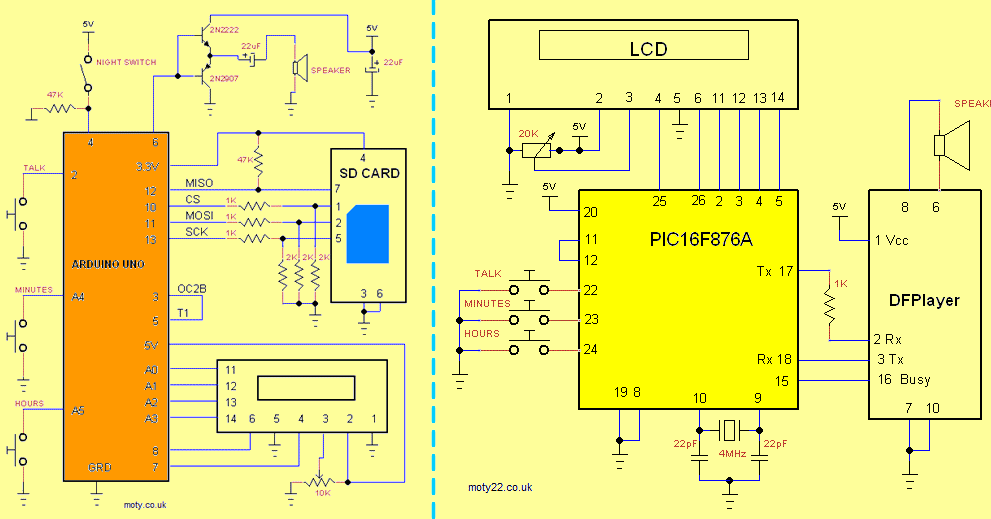
Arduino USB Hid Circuit
Including Visual Basic 6 code and arduino code to connect to Arduino Uno. VB6 may need an ActiveX file downloaded from Microsoft. VB application connects to Arduino and connects Arduino IDE via COM PORT created by USB driver, you cannot program Arduino while VB application is running. You must enter the port number in the VB application as done with the IDE. The application shows 4 analog inputs A0-A3, 6 digital inputs D2-D7 and 6 digital outputs D8-D13.
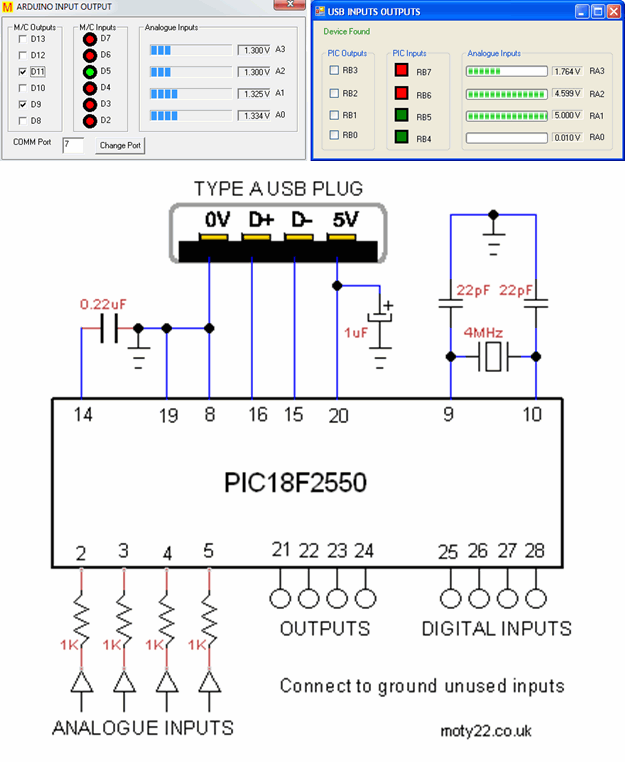
Arduino Doorbell (SD Card, Eeprom)
Arduino Uno doorbell project. Firmware works only on SD or SDHC cards. Do not use SDXC cards with this project because some of them work on the 1.8V drive. The code detects whether the card is SD or SDHC and selects the appropriate addressing system for the card. It has the necessary functions to read the SD / SDHC card formatted in FAT32.
The Arduino software can only play PCM 22.050KHz, 8 bit, mono. The bytes in the file are transferred to the PWM generator and you receive the sound with an external low pass filter. PWM gives 64KHz wave with duty cycle adjusted according to the amplitude. The low pass filter removes the 64KHz component.
The SD card interfaces the Arduino microcontroller in SPI mode. Reading the data is very blocky. The Error LED indicates a communication error with the SD card. The software only searches for file entries in the root directory and transfers any file type without reading its name or type.
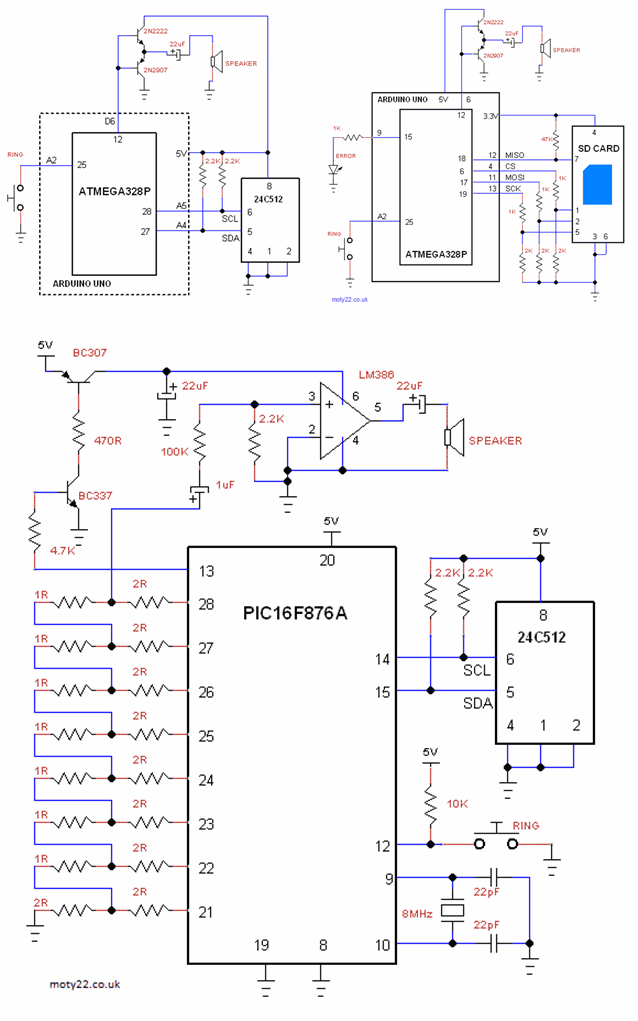
Arduino android frequency counter circuit
Arduino gradually creates an accurate time base of 1 second for the counter. The connection between digital inputs 3 and 4, timer2 connects the 250 Hz output to the timer0 input. The software waits for the timer0 output to be positive to start the frequency input number to timer0. Timer1 is a 16-bit timer, overflowing the power of 16, which improves overflow recording. At the end of 1 second, a 16-bit register is saved.
Arduino then calculates the frequency and period and displays them on the LCD. LCD screen and driver have 14-way connector, 10 connections are used, 4-bit bus is selected. There are a wide variety of LCD modules and their characteristics are very similar. The LCD module must be HD44780 compatible. Frequency input is TTL signal levels, a video amplifier must be added for low signal. Specifications recommend input up to 6MHz, I tested it at 2MHz.
Other versions; USB Android Arduino, Bluetooth Android Arduino
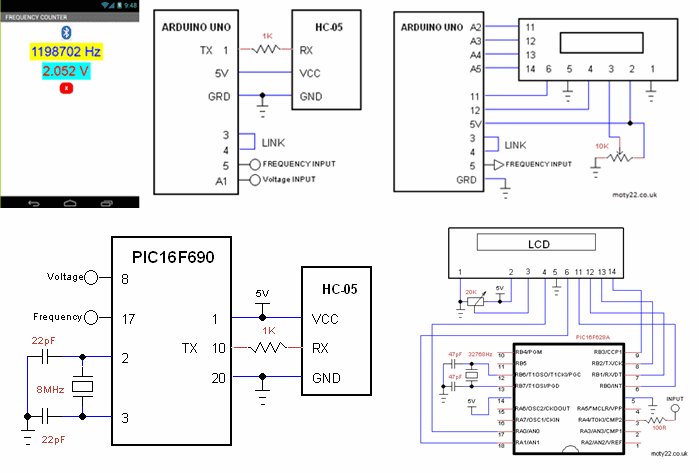
Arduino Lime Remover Water Softener Circuit
The water softener descaler circuit produces a frequency between 400Hz and 5KHz. It can give good results in some hard waters. The output of Arduino is 64KHz Pulse Width, modulated from 400Hz to 5KHz, the 220uH coil blocks the high frequency and operates the coil with about 1A current on the pipe, which provides high efficiency with less heat and less cost. Limits to 1A. 8-pin PDIP is an integrated mosfet driver. Mosfet drives that can be used: TC4420, MCP1406, MAX4420. These are very similar and the pins are the same.
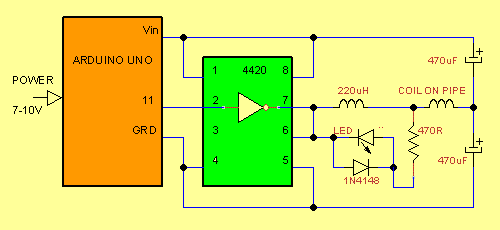
Arduino WiFi ESP8266 – Browse the data sent to your website from ESP8266.
Programming is done using the Arduino IDE. ESP8266 is connected to the local network. At the request of any internet browser connected to the same network, the ESP8266 server responds with a new temperature reading, otherwise the server listens for requests.
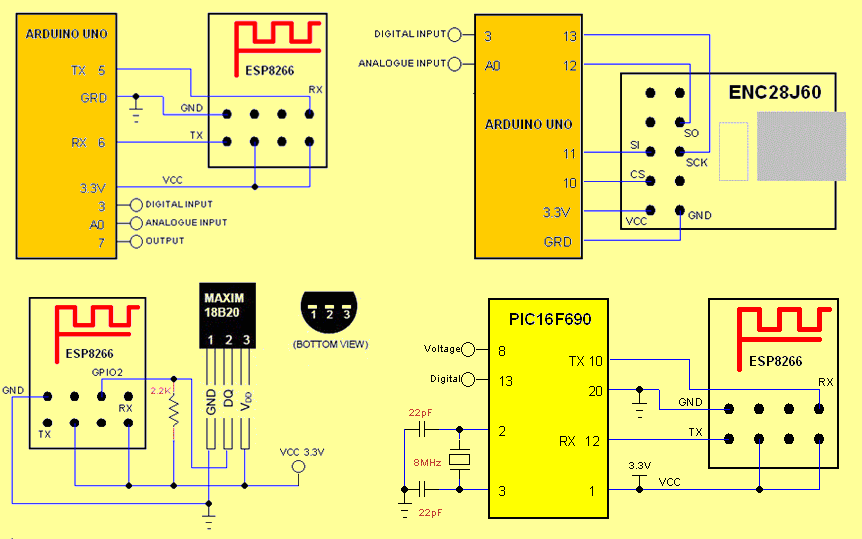
Arduino Voice Recorder Circuit
A sound recording project with Arduino Uno. Firmware works only on SD or SDHC cards. Do not use SDXC cards with this project because some of them work on the 1.8V drive. The code detects whether the card is SD or SDHC and selects the appropriate addressing system for the card. The sound quality is reasonable. ADC converts sound to 20KHz 8-bit mono, similar to .wav files. Timer0 in fast PWM mode is used as the DAC to convert digital data back into sound. During recording, ADC converts the sound to 10 bits, the low byte is transferred to the SD card. A 0.65V deviation to the ADC input is for setting the signal to the low byte of the converter output.
The SD card interfaces the microcontroller in SPI mode. Reading and writing data is in multiple blocks. Memory is used at 20KB / s speed. The Error LED indicates a communication error with the SD card. The software does not use any file system, it uses absolute memory addresses (raw).
The audio input is 1Vp-p, you can use the microphone circuit or other source. PWM gives 64KHz wave with duty cycle adjusted according to the amplitude. The low pass filter removes the 64KHz component. I added a simple 2 transistor amplifier to increase the power of using 32 Ohm speakers or headphones.
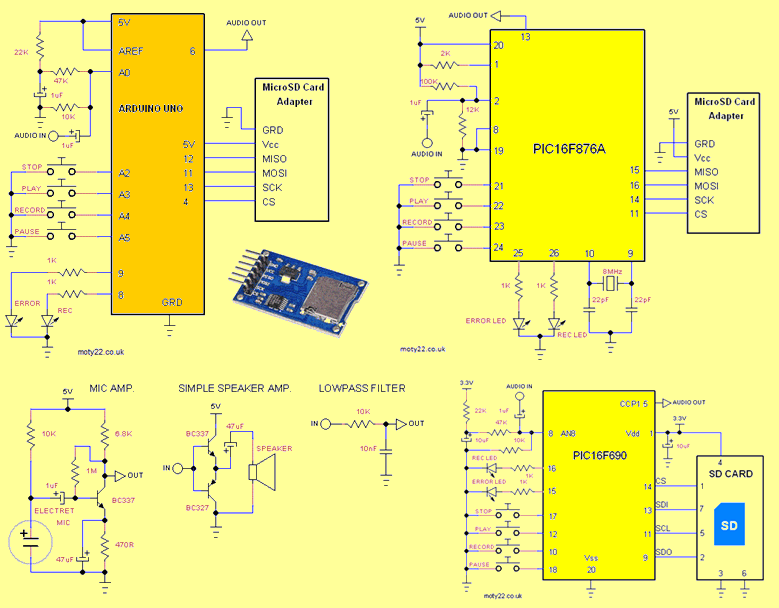
Source: moty22.co.uk
FILE DOWNLOAD LINK LIST (in TXT format): LINKS-26661a.zip
Published: 2020/04/26 Tags: arduino projects, microcontroller projects
Circuits Arduino intéressants
Certains projets avec des microcontrôleurs PIC ont été mis en œuvre avec des modules Arduino. Conversion du logiciel Arduino pour PIC ou vice versa, mais pas très intéressant. Il existe des codes sources Arduino et PIC.